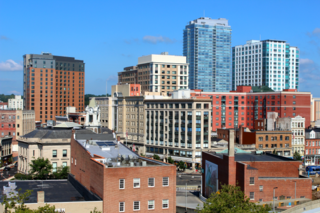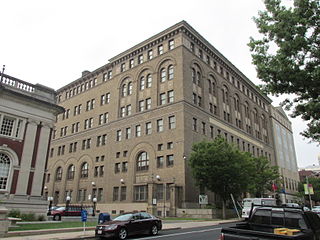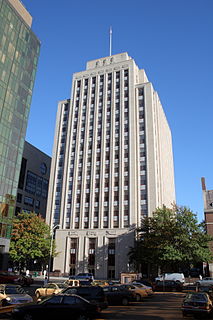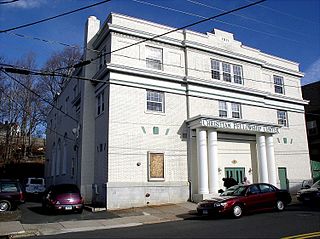
Downtown Stamford, or Stamford Downtown, is the central business district of the city of Stamford, Connecticut, United States. It includes major retail establishments, a shopping mall, a university campus, the headquarters of major corporations and Fortune 500 companies, as well as other retail businesses, hotels, restaurants, offices, entertainment venues and high-rise apartment buildings.

G. Fox & Co. was a large department store that originated in Hartford, Connecticut. The store was also the largest privately held department store in the nation when it was sold in 1965 to the May Department Stores Company. In 1993, May Department stores phased-out the G. Fox & Co. name converting them into the Boston-based department store Filene's. In 2005, the May Company merged with Federated Department Stores which converted the store and several other regional chains to Macy's.

The Detroit–Columbia Central Office Building is a building located at 52 Selden Street in Midtown Detroit, Michigan. It is also known as the Michigan Bell Telephone Exchange. The building was listed on the National Register of Historic Places in 1997.

The Southern Bell Telephone Company Building, now known as the AT&T Communications Building, is the main telephone exchange for downtown Atlanta, Georgia. It is located at 51 Peachtree Center Avenue, on the northeast corner of Auburn Avenue.

The William R. Cotter Federal Building is a historic post office, courthouse, and federal office building located at 135-149 High Street in Hartford, Connecticut. It was the courthouse for United States District Court for the District of Connecticut until 1963.

The Department Store Historic District is a historic district in the Downtown Hartford neighborhood of the city of Hartford, Connecticut, United States.

The Telephone Exchange Building is a historic building at 23 Union Street in downtown Norwich, Connecticut, behind Norwich Town Hall. Built in 1906-07, it was the first purpose-built telephone exchange building in the city, and is a little-altered example of period exchanges built by the Southern New England Telephone Company. The building now houses city offices. It was listed on the National Register of Historic Places on November 28, 1983.

The Pratt Street Historic District of Hartford, Connecticut, encompasses all of Pratt Street, between Main and Trumbull Streets, in the city's downtown. This block, which includes 15 buildings, is the only place in the city where its typical early 20th-century streetscape is retained. All of the buildings in the district were built between 1830 and 1928, a significant number of them designed by major local architects. The district was listed on the National Register of Historic Places in 1983.

The Elm Street Historic District encompasses a collection of architecturally distinguished institutional and residential buildings near the Connecticut State Capitol in Hartford, Connecticut. Located on Capitol Avenue and Trinity and Elm Streets, it includes the city's best concentration of early 20th-century architecture, including Bushnell Memorial Hall and several state office buildings. It was listed on the National Register of Historic Places in 1984.

The Eli, formerly the Southern New England Telephone Company Administration Building, is a skyscraper at 227 Church Street in downtown New Haven, Connecticut. Completed in 1938, it is the city's finest example of Art Deco architecture, and was headquarters to the Southern New England Telephone Company (SNET), which oversaw the building of the state's telephone networks. Designed by Douglas Orr and Roy W. Foote, it was added to the National Register of Historic Places in 1997.

The Simsbury Bank and Trust Company Building, also known as the former Town Hall Building, is a historic commercial and civic building at 760 Hopmeadow Street in Simsbury, Connecticut. Built in 1917, it is a prominent local example of Colonial Revival architecture with Beaux Arts features. It originally housed the town's first bank, and was its town hall between 1969 and 1984. The building was listed on the National Register of Historic Places in 1986.

The Downtown Waterbury Historic District is the core of the city of Waterbury, Connecticut, United States. It is a roughly rectangular area centered on West Main Street and Waterbury Green, the remnant of the original town commons, which has been called "one of the most attractive downtown parks in New England."

The Main Street Historic District of Bristol, Connecticut encompasses much of the city's central business district, an area built up in the late 19th and early 20th centuries. The district's 19 historic buildings are located along adjoining stretches of Main and Prospect Streets, and include important civic and commercial buildings. The district was listed on the National Register of Historic Places in 1995.

The Buckingham Building is a 27-story skyscraper located at 59-67 E. Van Buren St. in the Loop neighborhood of Chicago, Illinois. The building, which opened in 1930, has historically served as a mixed-use retail and office building. Chicago architects Holabird and Root designed the building in the Art Deco style. It was added to the National Register of Historic Places on August 10, 2000.

The Northwestern Bell Telephone Company Regional Headquarters building in Omaha, Nebraska was built in 1957 as the headquarters of Northwestern Bell, the telephone company that served Nebraska, Iowa, South Dakota, Minnesota, and North Dakota. The building was listed on the National Register of Historic Places in 2009 for its architectural significance as a modern corporate office building in Omaha, as well as Omaha's status as a regional center of communication and commerce at the time.

116 John Street is a historic office tower at the southwest corner of John Street and Pearl Street in the Financial District of Lower Manhattan in New York City. It was built in 1931, and is a 35-story brick and terra cotta building consisting of a three-story base, a 19-story shaft, and 12 upper stories that recede in a series of setbacks. The building features Art Deco style design elements at the recessed entrances and in the lobby. Built as a speculative office building for insurance companies, the building interior was rehabilitated in 2013 and some floors converted to apartments.

The Polish National Home is an ethnic community support organization in Hartford, Connecticut. Its facilities are located at 60 Charter Oak Avenue, south of downtown Hartford, in an architecturally distinctive Art Deco building. It was built in 1930 to a design by Polish-American architect Henry Ludorf, and was listed on the National Register of Historic Places in 1983.

The Underwood Computing Machine Company Factory is a historic industrial complex at 56 Arbor Street in the Parkville neighborhood of Hartford, Connecticut. Developed beginning in 1917 by the Underwood Typewriter Company, it was used by that company and its successors for manufacturing, research, and development until 1969. It presently houses the artistic collaborative Real Art Ways and other organizations. The complex was listed on the National Register of Historic Places in 1989.

The Webster Memorial Building is a historic house at 36 Trumbull Street in downtown Hartford, Connecticut. Built in 1870 and extensively restyled in 1924, it is a rare example of Georgian Revival architecture in the downtown area, noted for its historical association with the Family Services Society, a prominent local charity. The building, now in other commercial use, was listed on the National Register of Historic Places in 1982.




















